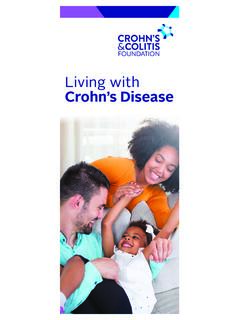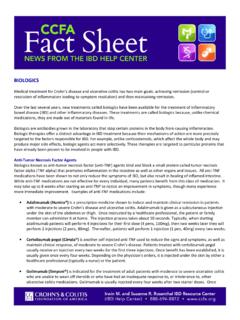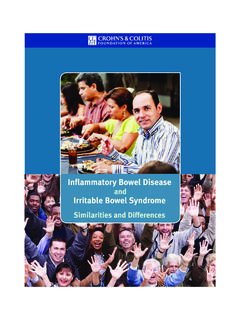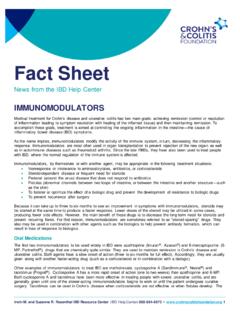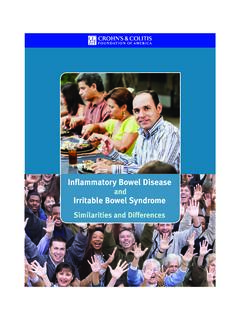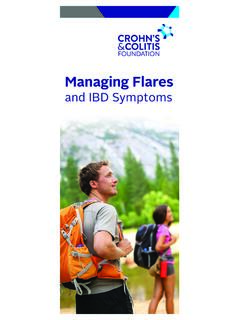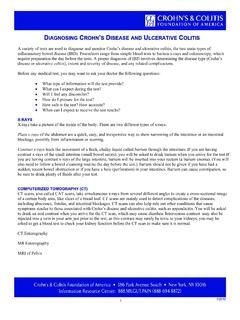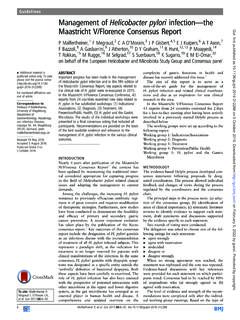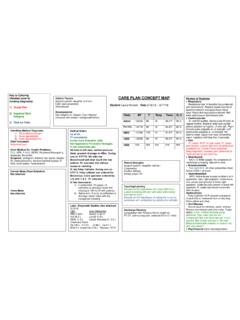Transcription of Inflammatory Bowel Disease vs. Irritable Bowel Syndrome
1 Inflammatory Bowel Disease vs. Irritable Bowel Syndrome1 IBD and IBS are two illnesses that can a ect the gastro-intestinal (GI) tract. Both can cause abdominal pain and changes in Bowel movements; however, they are not the same. While there are many similarities between IBD and IBS, it is important to highlight the di is the Di erence Between In ammatory Bowel Disease (IBD) and Irritable Bowel Syndrome (IBS)? Chronic in ammatory diseases involving the GI tract, including Crohn s Disease and ulcerative colitis. Immune cells cause in ammation and ulceration in the lining of the intestines, which can lead to frequent and/or urgent Bowel movements, abdominal pain, diarrhea, or bleeding.
2 In IBD, the GI tract is damaged. Symptoms can be di erent for everyone and depend on the type of IBD and where the in ammation is located in the GI tract. Functional GI disorder that causes recurrent abdominal pain and changes in Bowel movements. Symptoms may include bloating, constipation, diarrhea, or mixed diarrhea with constipation. Patients with IBS have these symptoms without damage to the GI tract. Endoscopy and radiology tests do not show in :IBS:2In ammatory Bowel DiseaseIBD is a term for chronic in ammation of the gastrointestinal tract.
3 The two most common in ammatory Bowel diseases are Crohn s Disease and ulcerative colitis (UC). IBD a ects as many as million Americans,1,2 most of whom are diagnosed before age 35. There are currently no cures for IBD, but there are treatments to reduce Bowel in ammation and control the symptoms of the s Disease and UC cause chronic in ammation of the GI tract. Crohn s Disease can a ect any part of the GI tract, but frequently a ects the end of the small intestine and the beginning of the large intestine (colon). The in ammation in Crohn s Disease can involve the entire Bowel wall.
4 UC a ects only the large intestine (colon) and the rectum. The in ammation in UC involves only the inner lining of the symptoms of IBD vary from person-to-person, may depend on what part of the Bowel is a ected by in ammation, and may change over time. Common symptoms for Crohn s Disease and UC include frequent and/or urgent Bowel movements, diarrhea, bloody stool, abdominal pain, and with IBD may also report symptoms such as fatigue, lack of appetite, and weight loss. People with IBD may have times of active Disease ( are), when symptoms and Bowel in ammation are present.
5 They may also have times of remission, when little or no symptoms are present. When Bowel in ammation is reduced by taking an e ective medication treatment, ares are less exact cause of IBD remains unknown. Researchers believe that a combination of factors interact, leading a patient to develop IBD. Inherited genetic risk Environmental risk factors Imbalance or changes in the intestinal bacteria (gut microbiome) An inappropriate reaction from the immune systemNormally, immune cells protect the body from infection, but in people with IBD, the immune system mistakes harmless substances in the intestine for foreign substances and launches an attack, causing in Gets IBD?
6 As many as 70,000 new cases of IBD are diagnosed in the United States each year. Age: IBD can occur at any age, but the median age of diagnosis is years for Crohn s Disease and years for ulcerative Gender: In general, IBD a ects men and women s DiseaseAge of onset: 15 35 years and 55 70 yearsSymptoms: Depends on location of Disease . May include abdominal pain, diarrhea, weight loss and stool: VariableMalnutrition: CommonUlcerative ColitisAge of onset: 15 35 years and 55 70 yearsSymptoms: May include stool urgency, fatigue, increased Bowel movements, mucous in stool,nocturnal Bowel movements and abdominal stool: CommonMalnutrition: Less commonContinuous anduniform inflammationin the large bowelPatchy inflammationthroughout smalland large bowelStricture3 Ethnicity: IBD is more common among Caucasians, but it can a ect people of any racial or ethnic group.
7 Family history: The risk for developing IBD is between percent and 28 percent for rst-degree relatives of an a ected Cigarette smoking: Smokers are more likely to develop Crohn s Disease . UC is more common in non-smokers and former ProceduresTo help con rm a diagnosis of Crohn s Disease or UC, one or more of the following tests and diagnostic procedures may be performed: Blood tests: The presence of in ammation in the body can be identi ed by examining the levels of several factors in the blood, including red and white blood cells, platelets, and C-reactive protein (CRP) a protein made by your liver that is sent into your bloodstream in response to in may be performed to help healthcare pro-viders di erentiate IBD from non-IBD.
8 Blood tests can be used to evaluate a patient s risk of develop-ing Disease complications, or to check if and how medications are working in the body. Stool tests: Stool tests may check for infection or in ammation (fecal calprotectin) in the GI tract by examining levels of a protein in the stool called fecal exact cause of Crohn s Disease and UC remains unknown. Researchers believe that several factors, such as genetic risk and an inappropriate reaction from the immune system, play a role in their development. Endoscopic procedures: Endoscopies get a detailed look at the inside of your digestive tract using a small camera mounted to the end of a lighted s Disease :An upper endoscopy lets doctors see the GI tract from the top down, using a exible, lighted tube that s inserted through your mouth, down the esophagus, into your stomach, and as far down as the duodenum, which is the rst section of your small colitis:A sigmoidoscopy allows your doctor to examine the extent of the in ammation in your lower colon and s Disease and ulcerative colitis.
9 A colonoscopy allows doctors to examine the colon, the lowest part of your large intestine, by inserting a exible, lighted tube through the opening to your anus. External imaging procedures: Images of the digestive organs and other soft tissues are taken from outside the body. Examples include computerized tomography (CT) scans and magnetic resonance imaging (MRI).IBD ComplicationsPossible complications of IBD can include: Bowel obstruction Deep ulcerations Extraintestinal manifestations Infection Malnutrition Precancerous changes in the colon or colon cancer4 Irritable Bowel SyndromeIBS is a condition that a ects the function and behavior of the intestines.
10 Normally, the muscles lining the intestines contract and relax to move food along the digestive tract. In IBS, this pattern is disturbed, resulting in uncomfortable symptoms. In addition, there can be a disturbance in sensation, with heightened sensitivity to normal gas or stool passing through the GI tract. It is important to remember that patients with IBD can also have IBS, but having IBS does not lead to people experience mild symptoms of IBS, but for some, symptoms can be severe. Symptoms can include cramping, abdominal pain, bloating, gas, mucus in the stool, diarrhea, and/or constipation.

